Genre: Platformer Developer: Vic Tokai Publisher: Vic Tokai Players: 1 Released: 1993
They say necessity is the mother of invention, and this adage applies to no video game character better than Sonic The Hedgehog. Sonic emerged from the uncertain haze at the beginning of the Genesis’ life cycle, when it wasn’t so much a console war as it was Nintendo repeatedly dunking Sega’s head in toilet. The hedgehog was exactly what Sega needed, and he not only saved the Genesis from repeating the commercial failure of the Master System, but he led the charge against the Big N as well (bolstered, of course, by a series of aggressive, mud-slinging ad campaigns).
If necessity breeds invention, then success (particularly of the financial variety) breeds imitation. Before Sonic came around, a majority of the most recognizable video game characters had come from Nintendo. Sonic’s success encouraged other developers to try their hand at the process and most of them hedged their bets by followed Sega’s example closely. Soon, we had a virtual menagerie of anthropomorphic characters operating under the misconception that slicing off a piece of Sonic’s pie was as simple as rocking a dynamic first name and looking smug on the box art. At some point, Vic Tokai (of Trouble Shooter fame) realized it hadn’t come up with a character of its own, an oversight it rectified with the 1993 release of Socket. The rest of the world, having forgotten that Vic Tokai was still around in the first place, glanced up only briefly before turning back away in disinterest. For all I know, my own copy of Socket was the only one sold.
Socket is a cybernetic duck with a power cord coming out of his butt. In the year 2902, he is commissioned by the Time Warp Patrol to hunt down and destroy Time Dominator, an evil dictator who has been using his time machine to steal treasure from the past (and creating pesky rifts in the space/time continuum in the process). It’s a rather grandiose setup for what is ultimately a pretty lackluster game, but the plot is hardly the worst part of this title.
The game’s main gimmick (so to speak) is Socket’s power cord tail. See, he starts each stage with his tail plugged into a power station, which fills his energy level. Predictably, he begins steadily losing energy as soon as he disconnects from the station but collecting energy items (floating lightning bolts in lieu of rings or coins) will restore it in small increments. At the end of each stage, Socket will find another power station that he can plug himself back into, where his remaining energy is calculated into his score.
Other than the opening and closing animation for each level, Socket’s only distinguishing feature never comes into play. Many games have been accused of ripping-off Sonic’s gameplay, but most of those games at least tried to make a few adjustments to convey some semblance of identity. Socket, on the other hand, has no such ambitions. It doesn’t want to distinguish itself from its inspiration. In fact, it plays so much like a laundry list of key elements from Sonic The Hedgehog that it’s easy to imagine the developers checking them off as they programmed the game. Multi-tiered, zig-zagging levels? Check. Colorful environments and plenty of parallax scrolling? Check, check. Bonus levels with swirling, psychedelic backgrounds? Robotic animal enemies? Spring pads to pinball your character around the screen and extended sequences in which he is rocketed uncontrollably through loops and up vertical inclines? Check, check, and check!
The only Sonic staple that didn’t make it into Socket, however, is a sense of challenge. With a noticeable absence of one-hit kills like bottomless pits, the game becomes ludicrously easy. Taking any damage at all merely takes a few more notches off your energy gauge, which can then be almost instantly refilled by the plentiful energy icons.
As derivative as Socket is, however, a developer can’t possibly emulate a Sonic game so closely without the end result being at least a little fun. Admittedly, some enjoyment can be derived from this game, despite the fact that it comes nowhere near the perfection of the original Sonic (it might come close to the Game Gear titles, though). In a nutshell, that is Socket’s greatest downfall. It’s not just the complete lack of originality present in this title; it’s the inability of the developers to make a product that was remotely as good as the one they were trying so carefully to duplicate. I imagine even the designers at Vic Tokai were scratching their heads a bit as they viewed Socket in its completed form. They followed the Sonic formula to a tee, so how did their game turn out so mediocre?
For starters, the graphics just aren’t that good. While it is certainly colorful and there are some impressive background effects in place, much of the game still doesn’t look much better than a first-generation title. Additionally, the musical tracks for each round sound far too similar and the sound effects are the absolute pits. The irritating zap of each collected lightning bolt, for example, is practically unbearable, and the alarm that sounds when your energy is getting too low sounds exactly like a McDonald’s deep fryer when the fries are done. Finally, as a character, Socket is probably the most charmless, uninteresting design that I have ever laid eyes on. A poorly-drawn, geeky duck in red jogging shorts, yellow gloves, and a technicolor ball cap? This poor chump probably spent more time getting poled in high school than he ever did saving the world.
As a game, is not necessarily that bad – it’s just laughably unoriginal. Except for Socket’s superfluous power cord tail, Vic Tokai made absolutely no attempt to innovate; no doubt counting on the shameless regurgitation of the Sonic formula to carry their game to success. It is the developer’s ineptitude rather than their complete lack of imagination, however, that keeps this game from rising any higher than mediocrity.
SCORE: 6 out of 10

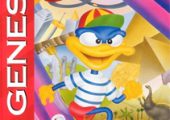
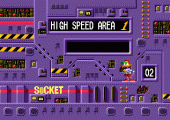
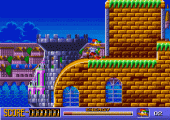
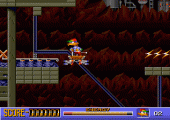
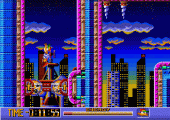
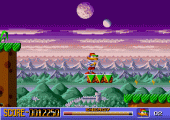
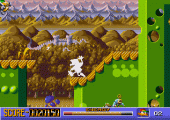
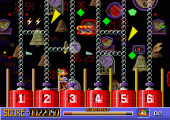
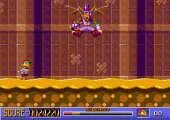
I do enjoy this game, but mostly for the graphics and music. Not much replay value and some of the stages feel very empty. 6/10 is appropriate.